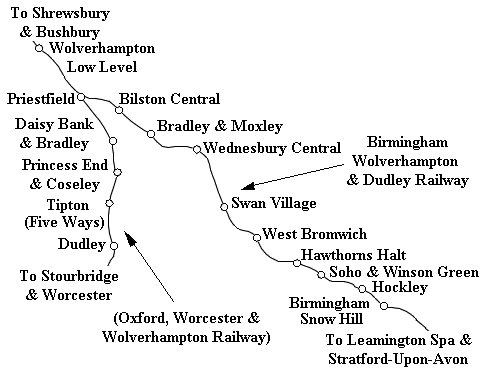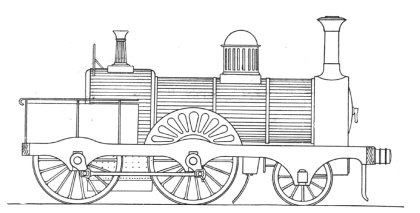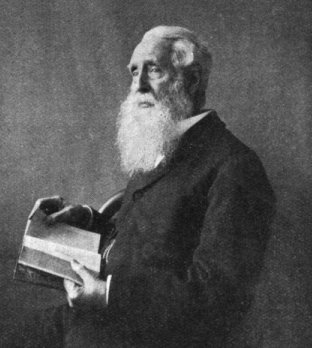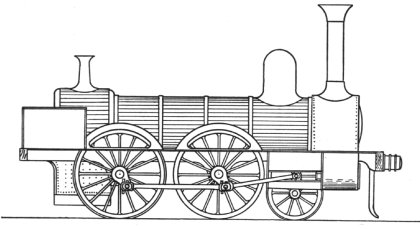 |
Rails In Wolverhampton - The Early Years
by Bev Parker |
 |
The Great Western Railway
Beginnings
The Great Western Railway was originally founded to provide a route from
Bristol
to London, using broad gauge track as developed by its chief engineer I. K.
Brunel.
It wasn't long before its sights turned northwards due to the success of its
standard
gauge rivals, the Grand Junction Railway, and the London & Birmingham
Railway.
To this end it actively encouraged any broad gauge railway company that had
set
its sights on alternative routes to the midlands and the north. One such
company
was the Oxford, Worcester & Wolverhampton Railway, and the GWR agreed to
provide three and a half percent of its capital.
The Oxford, Worcester & Wolverhampton
Railway |
|

The
original GWR lines into Wolverhampton. |
On 4th August 1845 a Bill was passed that authorised the company to
construct
a line from the Oxford & Rugby Railway at Wolvercot Junction to Worcester,
Stourbridge, Dudley, and Wolverhampton, with a branch to the Grand Junction
Railway at Bushbury.Other branches included lines to Kingswinford, and
Tipton Basin.
The Bill was passed in the middle of the gauge wars and so it stated
that the
track was to be mixed gauge from Abbotswood near Worcester northwards. |
| It
also stated that if the Oxford, Worcester & Wolverhampton failed to complete
the line, the Great Western should either lease the line, or purchase the
company
and complete the line itself. The Bill also stated that the low level
station was to
be constructed and run jointly with two other companies; the Shrewsbury &
Birmingham Railway and the Birmingham, Wolverhampton & Dudley Railway. |
| The chief engineer was I. K. Brunel and he greatly
underestimated the cost of
construction.
His estimate for the cost was one and a half million pounds
whereas
it was quickly realised that it would actually cost about one million pounds
more. Due to this the Great Western increased their share to four percent. |

Engine
No. 21. Oxford, Worcester & Wolverhampton Railway. |
| Progress was slow and by 1st June 1849
all of the available money had been spent. Only the
middle section of the line was anywhere near complete, so the Railway
Commissioners ordered the Great Western to complete the line. They refused,
and a legal battle started. Meanwhile the loyalty of the Oxford,
Worcester & Wolverhampton towards the Great Western began to decline, and an
agreement with the London & North Western and the Midland Railway was
signed on 21st
February 1851, which allowed those companies to finish the line themselves,
and
then run on it. The Great Western were furious and had the agreement made
void,
then offered the company a similar deal on their own terms. |

David Joy (in later life) who became Oxford, Worcester & Wolverhampton Railway's Locomotive Engineer. |
The Great Western leased the line, but the
ungrateful Oxford, Worcester &
Wolverhampton made approaches to the London & North Western to reach
Wolverhampton on the Stour Valley line with a junction at Tipton.
The GWR
protested to Parliament who refused to sanction such a thing and threatened
the company with heavy penalties unless the line reached the Low Level
station
and Cannock Rd Junction by September 1853.
The line was eventually finished
in July 1853, and opened on 1st December. |
Birmingham, Wolverhampton & Dudley Railway
The Great Western reached Birmingham via the Birmingham & Oxford
Railway, a logical extension of which would be a line from Snow Hill station
to Wolverhampton via the Birmingham, Wolverhampton & Dudley Railway.
The act for both railways was passed on 3rd August 1846 and the two
companies quickly joined forces, and were purchased by the Great Western
on 14th November 1846. Construction from Snow Hill started in 1851 and
the line opened on 14th November 1854 after a delay caused by a collapsed
bridge over a road between Soho and Handsworth stations. The bridge failed
on the 26th August, which was the day after which it had passed a Board of
Trade inspection. Intermediate stations were Priestfield, Bilston
Central,
Bradley & Moxley (opened later, June 1860), Wednesbury Central, Swan
Village, West Bromwich, Hawthorns Halt, Handsworth & Smethwick, Soho
& Winson Green, and Hockley.
Wolverhampton Junction Railway
This seemingly insignificant line was
authorised by an Act of Parliament in 1852,
and ran from Stafford Road Junction on the Shrewsbury & Birmingham line,
through the middle of their Stafford Road site to the Low Level station, a
total
length of three quarters of a mile. The Oxford, Worcester & Wolverhampton
Railway also had running powers over it, and it gave the Shrewsbury &
Birmingham access to the Low Level station.
Running
A wide variety of services soon began to stop at the Low Level. By August
1862 eleven trains ran from Wolverhampton to Oxford, the fastest time being
3hrs 25mins. There were trains to Evesham, Worcester and Dudley. The ex-Shrewsbury & Birmingham trains were still running their nine trains-a-day
service which was extended to include a stopping service through to
Liverpool
or Manchester. The busiest local service was the one to and from Snow Hill.
There were 19 trains running daily on
this route, and this number was increased
to 27 in 1865. Some of these came from Leamington Spa, Stratford, Knowle,
or Solihull. From 1st November 1868 all trains here began to run on standard
gauge except for one daily train to and from Paddington. Things didn't
change
much during the 1870's because all efforts went into the conversion from
broad
gauge to standard gauge in the south west and south Wales.
|
| In 1880 things again started to
improve. On 1st June the Paddington to Birkenhead expresses
stopped here and were known as the Zulu Express. In 1889 extra
Paddington expresses were added increasing the number to 7
daily, and this was increased to 10 daily from July 1891.
The number of trains in the popular
Wolverhampton to Birmingham service were increased to 43 trains
daily in 1902, and to 49 trains daily in 1939. |

Engines
D and E. Oxford, Worcester & Wolverhampton Railway. |
| By this time there were 39 trains
running daily on the Oxford, Worcester line. 1910 saw the
introduction of joint services between the Great Western and the
South Eastern & Chatham Railway. The Continental Express ran to
London Victoria, and then to Paris. The joint service with the
London & South Western Railway saw the start of services between
Bournmouth, Manchester and Birkenhead. In 1957 the famous Blue
Pullman started a must faster service to Paddington but this was
short lived, as services were soon in decline, prior to eventual
closure. Closure
From the 1960's closure looked inevitable as all investment
locally was made in the electrification scheme for the West
Coast Mainline. Although there was a temporary increase in
traffic while work was in progress, services were soon
reduced when the work was completed. The last Paddington to
Birkenhead express ran in March 1967, and a year later all
services on the ex-Shrewsbury & Birmingham line were diverted to
the High Level. Closure of the old Oxford,
Worcester & Wolverhampton line started with the Priestfield to
Dudley section on 22nd September 1968. The line to Birmingham
officially closed on 4th March 1972 but sections stayed in use
for freight until the mid 1980's. Work on
lifting the last section of track between Wednesbury and Swan
Village was finished by 27th July 1985.
|
 |
Return to the
previous page |
|